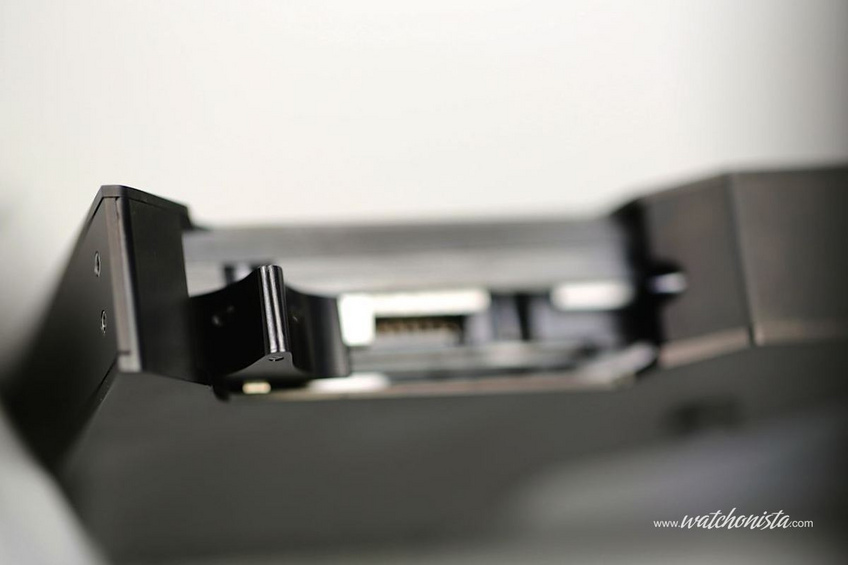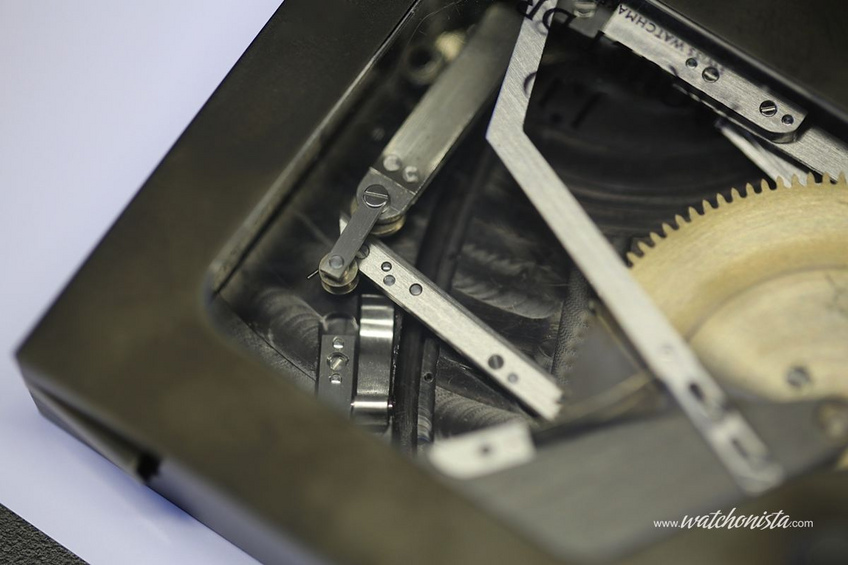
The Signing Machine by Jaquet Droz
This UFO is an amazing concentrate of micromechanics. It was launched at Baselworld this year and it continues the tradition of ancestral watchmaking, close to the expertise of great automata creators.
The machine reminds us of technical, built-in objects with an industrial and functional connotation. In our recent collective unconscious – around the 1980s – this machine could have been one of those ultra-compact Nagra recorders or a gadget from a Bond movie. It also reminds us of those big tapes that were inserted in sound diffusing instruments at the dawn of the digital era. Yet, the size of the signing machine has been inspired by the smartphone – a very contemporary object. The reason for this is that the department of automata production of the Manufacture Jaquet Droz had set the objective of not producing an instrument bigger than a cell phone. The length and width of the machine are dead on, but it is a bit thicker than a phone.
Imagined customization
In any case, the shape of this machine will evolve according to the external parts that the technical team will cover it with to customize it.
Will it be curvier, less angular or shinier? Nothing is final yet but ideas are overflowing and there is no lack of in-house skills to materialize them. However, for the time being, the presentation model is in titanium, which is fortunately not too light as the weight gives the impression of something very mechanical. Its rough shape has already generated positive comments. The interest for it in Basel was tangible even though its price has not yet been fixed.
The ultimate customization of such a machine is, of course, the signature of its buyer. Indeed, its future owner will have to sign a disclaimer at the moment they receive the piece as a guarantee against ill-intentioned individuals who may use it for the wrong purposes. Through a scan supplied on request, the machine reproduces such a close replica of one’s signature that it is completely legitimate to imagine that it might be used against its owner if it falls into the wrong hands. Fortunately, it has a 4-digit security code – purely mechanical – that prevents unauthorized use. When the owner enters the code, the machine will send the scanned signature. The code for their demonstration model could be no other than 8888, the brand’s fetish number. Its signature is obviously “Jaquet Droz”, the same that has been used before and the one we can find in the archives.
It is written in cursive, in a fluid style and with scriptural phrasing that speaks volumes about the control exerted by the three cams. The aim of these is to dictate the movements of the retractable and folding arm by mechanical means only.
A complicated, yet user-friendly, mechanism
The center of this signing machine consists of interlaced gear trains –visible through a glass aperture– and a barrel charged with enough energy to make three successive signatures. These are done by a trigger winding mechanism located on the side of the machine. They are perfectly identical –as was proved at the private demonstration to which I was invited– and make the arm pivot two times in a row. The initial line is barely increased. The Schmidt ball-point pen, specifically designed to fold back into the other side of the engine, is placed vertically on the arm in the aperture carved for it and it reproduces fine writing even when redone. Its recharging is internationally standard.

The construction of the signing machine is simple and efficient. Customization thus resided in the construction of the three cams – similar to those used by Jaquet Droz and his son when they were creating their “Writer” automaton.
There are three cams for three axes; one horizontal, one vertical –to raise and lower the pen– and one for depth. These are the only superposed pieces since the whole mechanism has been designed horizontally to better fill the spaces between the walls, unlike the “Writer” which was designed vertically. A little adjustment of the springs here and a subtle sharpening there and we obtain fluid, cursive writing.

Back when Jaquet Droz crafted his automata, the humanoid dimension he gave them completely explained why he was labeled a magician throughout his travels and journeys in some recluse areas of the world. Today, this Signing Machine also gives off a paranormal je ne sais quoi. Quite difficult to take our eyes off such a spectacle.
The magnified history of watches and automata
Pierre Jaquet-Droz – born 1721 and deceased 1790 – was above all a great watchmaker and the first one to be admitted into China’s “Forbidden City”. Still today, his automata hold a great importance in museums.
For example, his automaton “The Writer” is considered to be the ancestor of computers, as it was able to write a sentence in cursive writing. He was Martin Scorsese’s inspiration for his movie “Hugo”. The brand clearly intends to magnify this legacy under the leadership of Marc Hayek. In 2014, it is definitely succeeding with this Signing Machine after managing to produce the “Bird Repeater” which is an automaton coupled with a minute-repeater housing a self-winding mechanism. In 2013 – on the occasion of the 275th anniversary of the brand – the very poetic “Charming Bird” watch was released. It featured a facial bulb housing the shakes and sounds of a true-to-life little bird. This territory of absolute exclusivity of the brand still has endless possibilities to offer.




